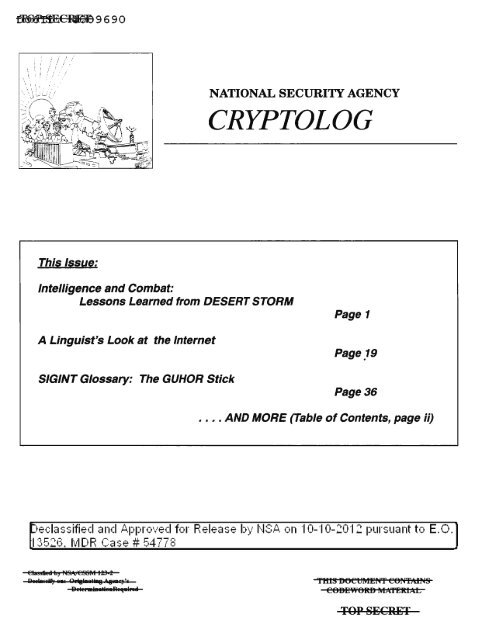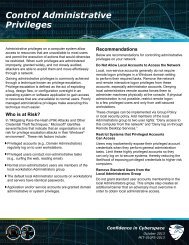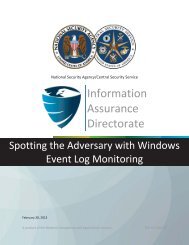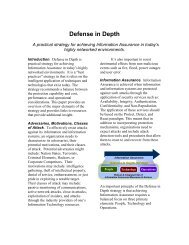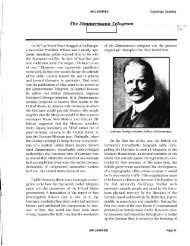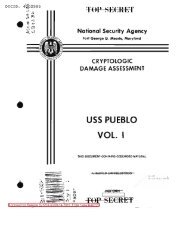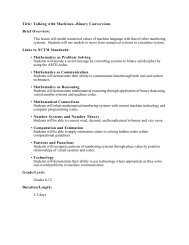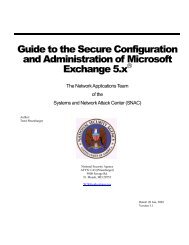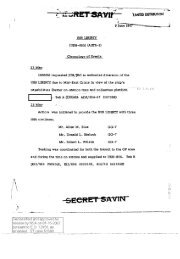CRYPTOLOG - National Security Agency
CRYPTOLOG - National Security Agency
CRYPTOLOG - National Security Agency
Create successful ePaper yourself
Turn your PDF publications into a flip-book with our unique Google optimized e-Paper software.
DOCID: 4009690<br />
<strong>CRYPTOLOG</strong><br />
July 1994<br />
6<br />
SECRE'F SPOKE<br />
SECRET SPOI'E<br />
IIANDLE VIA COMINT CIIANNELS ONL¥<br />
EO 1.4. (c)<br />
F.L.86-36
DOCID: 4009690<br />
EO 1.4. (c)<br />
P.L. 86-36<br />
SECREl?<br />
Target Development in the Field<br />
<strong>CRYPTOLOG</strong><br />
July 1994<br />
F;L. 86-36<br />
byl _<br />
fC ceQ) The purpose of this article is to discuss target development in the field and how it is different from target<br />
development as practiced by offices of primary interest (OPls) at NSA Washington (NSAW). These differences are<br />
important for Headquarters analysts to understand, because their ability to work with field target developers will have<br />
a direct effect on the product they receive from the field. The ideas in this article are drawn from the author's experiencel<br />
Ito discuss<br />
target development issues, and countless telephone and e-mail conversations with target developers around the world.<br />
While these thoughts are not universally applicable, they are valid, in varying degrees, for most large field sites.<br />
(C CCO) There are probably as many different definitions<br />
of target development as there are organizations<br />
doing it. One of the problems that arises in discussing<br />
the topic is figuring out what is meant by the phrase target<br />
development. Since it involves so many different<br />
types of activity. there are many different slants on its<br />
meanin.e;.1<br />
1\\<br />
SECRET<br />
IlANDLE ytA COMIN'f' CItANNELS ONLY<br />
\<br />
\/<br />
•<br />
EO 1.4. (c)<br />
P.L. 86-36<br />
7
DOCID: 4009690<br />
<strong>CRYPTOLOG</strong><br />
JUly 1994<br />
8<br />
SECRE'f'<br />
SECRET<br />
IIANBLE "itA COf\7I1N'f' CIIANNELS ONL"l<br />
EO 1.4. (c)<br />
P.L. 86-36
DOCID: 4009690<br />
P.• L. 86-36<br />
CRVPTOLOG<br />
July 1994<br />
10<br />
SECRET<br />
Highlights from the Spring SRTD Conference<br />
EO 1.4. (c)<br />
EO 1.4. (d)<br />
P •. L. 86-36<br />
··.........../i<br />
SEeREiT EO 1. 4. (c)<br />
HANDLE VIA COMINT CHANNELS ONL'l P . L. 86-3 6
DOCID: 400r9..6.9Di-36<br />
EO 1. 4. (c)<br />
EO 1.4. (d)<br />
SECRET<br />
SECRET<br />
fBLR Y'b\: COMIN'f' CIfANNi!;LS ONLY<br />
<strong>CRYPTOLOG</strong><br />
July 1994<br />
11
DOCID: 4009690<br />
<strong>CRYPTOLOG</strong><br />
July 1994<br />
P;L. 86-36<br />
INFOSEC Technical Exchange<br />
(V) The following guidelines should be used in writing<br />
an article for the INFOSEC Technical Exchange.<br />
These guidelines are intended to help a prospective<br />
author focus his/her efforts toward an article which<br />
meets the spirit of the Exchange. We invite all members<br />
of the INFOSEC Community to submit articles.<br />
Topics<br />
(V) Articles may address any topic which is of interest<br />
to a wide range of INFOSEC professionals. All articles<br />
should be:<br />
(V) Relevant, topical, and contribute to the advancement<br />
of the INFOSEC Community.<br />
(V) Timely, although historical articles may occasionally<br />
be used.<br />
(V) Mayor may not be highly technical; however, if<br />
the topic is highly technical, pay particular attention to<br />
the CONTENT guidelines below.<br />
Content<br />
(V) All articles should be of a professional nature<br />
and serve as a technical resource for the INFOSEC<br />
Community.<br />
(V) Articles may disseminate information on:<br />
• R&D efforts,<br />
• findings from general research,<br />
• recent developments in policy which have a broad<br />
impact,<br />
• new achievements in ongoing projects<br />
(V) Articles may introduce a new project or program<br />
that needs support from or offers support to a wide range<br />
of organizations.<br />
(V) Articles should interest a wide range of<br />
INFOSEC professionals.<br />
(V) Articles should be written on a level that will<br />
allow all readers to understand the main ideas presented.<br />
It is expected that there will be some cases in which<br />
highly technical details are essential for a complete article.<br />
This is acceptable, as long as comprehension does<br />
not depend on a clear understanding of the technical<br />
details. In general, technical complexity should be considered<br />
the exception rather than the rule.<br />
14<br />
FOR OFFICIAL USI; ONIX<br />
(D) Classification<br />
(V) The Exchange will accept and print articles up to<br />
the TOP SECRET level. Each paragraph in a classified<br />
document should be properly marked with its classification<br />
level (U, C, S, TS).<br />
(V) The Exchange is distributed to the branch level<br />
in the ISSO and is widely available to NSA employees<br />
and others with appropriate clearances for V.S. classified<br />
information. Protection of caveated or compartmented<br />
information cannot be supported.<br />
Length<br />
(U) Articles should be from one to ten pages long,<br />
including any relevant graphs, charts, diagrams, or schematics.<br />
If an article is longer than ten pages, the author<br />
may contact the publisher of the Technical Exchange,<br />
for a discussion or advice.<br />
Format<br />
(FQUQ) FrameMaker format is preferred. 1334 has a<br />
conversion service that converts Interleaf, Word Perfect,<br />
Office Writer and MS Word into FrameMaker. Just<br />
attach the document to an E-Mail Compose Window<br />
addressed to convert@po. In the message window,<br />
type:<br />
Target: FRAME<br />
Send it. The document will be converted and<br />
returned to you.<br />
(V) Classify all paragraphs.<br />
(U) Do not double-space between lines.<br />
(V) Do not type your article in capital letters.<br />
(V) Include your name, organization, building, and<br />
phone number.<br />
(U) Do not type your article in multi-columns.<br />
Submitting Items<br />
FOR OFFICIAL USB ONU'<br />
(U) All articles must be reviewed and approved by<br />
the writer's organization.<br />
(V) All articles must be approved for publication in<br />
the INFOSEC Technical Exchange by the Publisher and<br />
member(s) of the Selection Panel, who reserve the right<br />
to edit, abridge, or refuse to publish an article.<br />
. .<br />
P.L. 86-36<br />
..................
DOCID: 4009690<br />
CRVPTOLOG<br />
July 1994<br />
identification of that critical information. In today's<br />
environment of information exchange, it is simply not<br />
possible to protect all information that is associated with<br />
a particular program or initiative. Instead, that information<br />
which is absolutely critical to the success of a program<br />
(the "golden nuggets") must be identified and<br />
protected. Along with the identification of exactly what<br />
information is critical, a realistic assessment should be<br />
made of what, if any, information has already been compromised,<br />
or can reasonably be assumed to be known or<br />
available in the public domain. We are currently spending<br />
enormous sums ofmoney "protecting" information<br />
that has been publicly known for many years.<br />
(U) In identifying the threat to a particular piece of<br />
information, we should be careful not to rely on Cold<br />
War threat assessments of what an adversary "could" or<br />
"might" ascertain, or what his "probable" or "possible"<br />
capabilities are. In today's tight financial times, funds<br />
will be increasingly allocated toward defending against<br />
demonstrated, rather than postulated, threats. If there is<br />
a reasonably good indication that there is a threat to critical<br />
information, then countermeasures should be<br />
applied to that threat. We can no longer afford, however,<br />
to defend against threats that have never been demonstrated.<br />
We also need to assess the likelihood of a<br />
particular threat. Would an adversary mount a sophisticated,<br />
expensive, high-risk SIGINT operation against a<br />
particular target if he could get the same information<br />
from Nexis-Lexis or a similar database? In most<br />
instances, the answer would be no.<br />
UNCLASSIFIED<br />
(U) The assessment of vulnerabilities that could<br />
reveal critical information is an equally important part<br />
of the OPSEC process. It may be that existing security<br />
measures are adequately protecting critical information,<br />
but it is this phase of the OPSEC process that will result<br />
in that determination. By reconstructing the flow of<br />
information into, through, and out of an organization or<br />
project, the OPSEC analyst can identify the vulnerabilities<br />
of the critical information independently of security<br />
measures that are already in place. It will immediately<br />
become apparent whether or not the existing security<br />
measures are, in fact, protecting the information in question.<br />
(U) The culmination of the OPSEC process is the<br />
identification and application of countermeasures. It is<br />
in this area that OPSEC often stands alone as the economical<br />
alternative to more traditional (and often<br />
costly) security measures, because OPSEC countermeasures<br />
are frequently simple administrative changes.<br />
These changes can range in scope from the development<br />
of a deception plan, to the omission of a few items of<br />
information from a shipping label, to the decision not to<br />
release a particular item to a local newspaper. OPSEC<br />
involves an assessment of existing resources, followed<br />
by a subsequent plan of re-aligning these resources to<br />
provide the maximum protection for the identified critical<br />
information. Occasionally, OPSEC countermeasures<br />
will include additional changes that do have a cost associated<br />
with them, such as the provision of secure communications<br />
equipment, but this is not usually the case.<br />
(U) Viewed in this way, it becomes apparent that OPSEC can be a valuable tool for cutting costs without sac·<br />
rificing protection. By identifying the information that really needs to be protected, OPSEC ensures that this information<br />
is safeguarded by relevant countermeasures while eliminating unnecessary and often costly security measures<br />
that are oriented toward an undocumented or unlikely threat. Furthermore, if OPSEC is employed throughout the<br />
entire life-cycle of a program or system, as it should always be, it can provide further savings in the form of dollars<br />
that will not need to be spent re-developing or replacing a system or program that has been compromised even before<br />
it is fielded. The intention is not to imply that, in embracing OPSEC, we should throw existing security measures out<br />
the window. However, in practicing OPSEC consistently, we can determine which security measures are effective<br />
and which ones are not, and in the long run ensure that the dollars we spend on security are doing the most toward<br />
protecting our truly critical information.<br />
18<br />
UNCLASSIFIED
J<br />
DOCID: 4009690<br />
SECItF;'f' P. L. 86-3 6<br />
SECItE't'<br />
EO 1.4. (c)<br />
<strong>CRYPTOLOG</strong><br />
July 1994<br />
23
DOCID: 4009690<br />
<strong>CRYPTOLOG</strong><br />
24<br />
SHCRE'f'<br />
P.L. 86-36<br />
EO 1.4. (c)
DOCID: 4009690 SBCKBT<br />
General Guides to Using the Internet<br />
<strong>CRYPTOLOG</strong><br />
July 1994<br />
(U) The following are useful as introductory and general guides to using the Internet. A more comprehensive list of<br />
recent Internet books can be found in RFC #1432 by J. Quarterman, Mar. 93, available on-line by anonymous ftp<br />
from nie.ddn.mil in subdirectory Irfe as file rfe1432.txt.<br />
• Zen and the Art ofthe Internet: A Beginner's Guide to the Internet. 2nd ed.<br />
Brendan P. Kehoe, Prentice-Hall, 112 pp., $22.00. Probably the shortest of the introductory books. The on-line first<br />
edition, dated Jan 92, 96 pp., is available by anonymous fip from ftp. es.widener. edu in the pUblzen<br />
subdirectory as file zen-I. 0 .ps.<br />
• The Whole Internet User's Guide and Catalog<br />
Ed Krol, O'Reilly & Associates, Inc., Sebastopol, CA, 376 pp., 13 Sep 92, $24.95. Aimed more at graduate students<br />
who want to use the Internet for research. Ed's 1989 paper The Hitchhiker's Guide to the Internet, 22 pp., is available<br />
on-line by anonymous fip from uxe.eso.uiue. edu and other sources.<br />
• The Internet Companion: A Beginner's Guide to Global Networking<br />
Tracey LaQuey, Addison-Wesley, 196 pp., $10.95. Aimed at the general public. Being made available on line, two<br />
chapters per month, for anonymous fip from world. std. com.<br />
• Internet: Getting Started<br />
April Marine, SRI International, 333 Ravenswood Ave., Menlo Park, CA; 380 pp., Sep 92, $39.00. How to join the<br />
Internet, and some context so you will know why. Neither a guide nor a catalog, but contains numerous contact<br />
listings.<br />
• The Internet Passport: NorthWest/Net's Guide to our World OnLine. 4th ed.<br />
Jonathan Kochmer and NorthWestNet, Bellevue, WA, 450 pp., 1993. On-line version, Internet Resource Guide, 3rd<br />
ed., Oct 92, 300 pp., is available by anonymous ftp from ftphost.<br />
nwnet.net in nec/nwnet/user-guide subdirectory, file nusirg.whole-guide.ps. Z.<br />
• The New User's Guide to the Internet<br />
Daniel P. Dern, McGraw-HIll, New York, 1993.<br />
• An Internet Primer for Information Professionals: A Basic Guide to Networking Technology<br />
Elizabeth S. Lane and Craig A. Summerhill, Meckler Corp., Westport, CT, 200 pp. 1992, $37.50.<br />
• Crossing the Internet Threshold.' An Instructional Handbook<br />
Roy Tennant, John Ober, Anne G. Lipow, foreword by Clifford Lynch; 142 pp., 1993, $45.00. A short textbook on<br />
using the Internet, by two librarians at the University of California at Berkeley.<br />
• CICNet Resource Guide<br />
Available by anonymous ftp from nie.cie.net in subdirectory pub, file resoureeguide.<br />
25
DOCID: 4009690 'FOP SECRE'F lHtlBR-A<br />
realizing the growth potential of public cellular communications<br />
and a need for standardization among these<br />
systems, established the GSM Working Group. Specifically,<br />
it was tasked to provide an outline definition by<br />
December 1986 and a specification for a Pan-European<br />
public land mobile network by December 1988. Early<br />
in 1983, the working group had identified all competing<br />
systems and proposals, none of which were acceptable<br />
as candidates for the Pan-European system. To avoid<br />
standardization obstacles and any interference with the<br />
development of a new, clearly defined Pan-European<br />
system, the working group declared that all existing systems<br />
and system proposals would be considered<br />
"interim" systems.<br />
(V) In 1987 the Ministerial Council of the European<br />
Community (EC) urged all member countries to<br />
introduce the GSM system. According to this recommendation,<br />
the start date for the Pan-European digital<br />
cellular mobile radio system should be no later than<br />
1991, the most important city areas should be covered<br />
no later than 1993, and the main connections between<br />
covered areas should be no later than 1995. This recommendation<br />
was adopted in 1987 through a memorandum<br />
of understanding (MoV) between operators and telecommunications<br />
administrators of 16 European<br />
nations. Since then, others have signed the MoV, bringing<br />
the total number of signatories to 23 operators in 16<br />
European countries, as well as another 20 countries<br />
throughout the rest of the world. Most of these countries<br />
have agreed to abide by the terms of the EC recommendation<br />
including the stipulation to license at least<br />
two operators, one private and one public, thereby creating<br />
a competitive consumer market.<br />
(V) As the GSM working group's activities progressed,<br />
it became quite apparent that the analog systems<br />
currently deployed in Europe were overburdened<br />
and would be unable to meet future demand for public<br />
mobile cellular communications. Therefore, in 1987, it<br />
modified the GSM system specifications, citing a<br />
change from analog to digital technology. Since 1989,<br />
when the program was transferred from CEPT to ETSI,<br />
work on the GSM standard has continued as planned,<br />
and CEPT continues to provide an open meeting place<br />
for European telecommunication standardization activities.<br />
It should also be noted that, although CEPT and<br />
ETSI have been the overseers of the GSM program, various<br />
ad-hoc subgroups and joint groups have been<br />
formed periodically to assist in the development of the<br />
GSM standards. At one time there were as many as 28<br />
groups involved in the writing ofthe standard, as well as<br />
the theoretical, practical, and simulation studies associated<br />
with the program.<br />
'FOP SECRE'F mtBRA<br />
IMNBLE VIA COIt.UNF CIIAM'ffiLS ONL¥<br />
Why was GSM developed?<br />
CRVPTOLOG<br />
July 1994<br />
(V) Development of GSM is particularly important<br />
at this time, due to the political and economic changes<br />
sweeping the world today. Many of the Third World<br />
countries (including those in East Europe), are attempting<br />
to develop market economies patterned after those<br />
of the West, to which efficient communications are<br />
essential; therefore, many of these countries are planning<br />
massive upgrades of their telecommunications<br />
infrastructures and are intent on deploying state-of-theart<br />
equipment in order to compete.<br />
(V) Funding for such upgrades, if not nationally<br />
available, is in most instances readily available through<br />
various lending institutions like the International Monetary<br />
Fund and the European Bank for Reconstruction<br />
and Development, or through joint ventures with many<br />
western companies designing and building GSM-compatible<br />
equipments.<br />
(V) Various factors have driven the development<br />
of the GSM system, but probably the most important of<br />
these was the need to develop a standard to be adhered<br />
to by all digital mobile communications equipment<br />
manufacturers and suppliers. This standard will insure<br />
compatibility between equipment and provide a capability<br />
for the user to roam freely throughout Europe while<br />
maintaining communications with another party, be it<br />
through speech or data.<br />
(V) Another major factor was the phenomenal<br />
growth in the use and deployment of public analog cellular<br />
mobile networks. Several European countries, as<br />
early as 1983, had deployed mostly non-compatible systems<br />
operating in the 450MHz band. This rapid growth,<br />
especially in the Nordic countries, resulted in pressure<br />
to allow these systems to migrate operationally into the<br />
900MHz band-a logical migration, since the International<br />
Telecommunication Vnion (lTV) had already<br />
obtained approval from the World Administrative Radio<br />
Conference (WARC) to have this band designated for<br />
public mobile communications use in Europe.<br />
(V) The Vnited Kingdom was the first to allocate a<br />
portion of the 900MHz band for the operation of their<br />
first-generation analog system, known as the Total<br />
Access Communications Systems (TACS). Since that<br />
time, other countries have followed suit, and the V.K.<br />
has gone one better by allocating more of the 900MHz<br />
band, just below the original GSM spectrum allocation,<br />
for the operation of its Extended Total Access Communications<br />
System (ETACS).<br />
27
DOCID: 4009690 TOP SECRET ffitlBRA P.L. 86-36<br />
EO 1. 4. (c)<br />
tually, even those countries who initially chose an analog<br />
deployment will probably migrate to the GSM<br />
standard.<br />
(U) Adoption of the GSM standard by other world<br />
nations should also follow the pattern set by those countries<br />
throughout Europe. In the lesser-developed and<br />
Third World countries some will go the route of the<br />
western European countries and immediately deploy<br />
GSM systems, providing they can obtain the funds and<br />
COCOM-successor restrictions do not apply; others will<br />
delay deployment. In developed nations the need to<br />
immediately adopt a new cellular mobile standard will<br />
be less critical, since most have well-established telecommunication<br />
infrastructures to include a number of<br />
operational analog systems, or are in the process of<br />
developing their own digital cellular mobile standard, as<br />
is the case with Japan and the United States.<br />
(U) Therefore, the world's cellular mobile telecommunications<br />
picture will most likely, at least in the<br />
near term, remain a hodgepodge of analog and GMS<br />
digital cellular mobile communications systems, and the<br />
number of users/subscribers switching to the new GMS<br />
systems will not increase dramatically, due to the initial<br />
high costs of equipment and subscribership. In the long<br />
term however, as more services become available and<br />
costs decline, GSM will undoubtedly become a viable<br />
option for the public sector.<br />
Conclusions and Recommendations<br />
(U) GSM systems provide highly sophisticated<br />
communications. The vast majority ofcellular systems<br />
currently deployed throughout the world today are<br />
incompatible analog systems providing, at best, a<br />
national voice telephony capability and other limited<br />
services. When these systems are compared with a<br />
mature GSM digital system it becomes quite evident<br />
that the additional capabilities of GSM-increased data<br />
rates, improved signal quality, improved spectrum<br />
usage, improved security of communications, and compatibility<br />
of systems among countries--provide a cellular<br />
mobile communication system far superior and more<br />
sophisticated than those in use today.<br />
(U) GSM system deployments and subscribership<br />
will increase. There will be a continual migration<br />
from analog to digital mobile cellular communications,<br />
and the number of system deployments, as well as the<br />
number of subscribers, will increase as new phases of<br />
the GSM standard are introduced, additional services<br />
become available, and the costs of equipment and sub-<br />
't'OP SECRE't' mtBRA<br />
IIANf)LR --rIA COr.UN'f' CHANNELS ONL"i<br />
<strong>CRYPTOLOG</strong><br />
July 1994<br />
scribership to GSM networks diminish. The rate at<br />
which this migration and growth of subscribership<br />
occurs will differ worldwide, because of variances in<br />
governmental telecommunication policies, the current<br />
state of an individual country's telecommunications<br />
infrastructure, a desire\.to perpetuate a global market,<br />
subscribership growth \potential of current analog<br />
mobile cellular communications systems, availability of<br />
the required frequency spectrum, and the development<br />
of other digital cellular standards possibly providing<br />
capabilities superior to the GSM standard.<br />
29
DOCID: 4009690<br />
P.L. 86-36<br />
EO 1.4. (c)<br />
Bell/North American Standard<br />
(U) The Bell/North American standard has also<br />
been approved by the ccnT as a PCM standard. The<br />
Tl carrier, also referred to as a Bell Level 1, was introduced<br />
by Bell in 1962.and allowed for the multiplexing<br />
of 24 voice channels oyer one transmission medium.<br />
Each voice channel is composed of eight bits, giving a<br />
frame length of 192 bits (24 X 8). A 193rd bit is used<br />
for framing and signalling control. The Tl operates at a<br />
bit rate of 1.544 Mbps (8000 samples per second X 193<br />
bits). The T2, or second-level Bell system, was introduced<br />
in 1972 and carries 96 voice channels on a single<br />
transmission medium. The T2 is composed of four TIs,<br />
the T3 of seven T2s for a total of 672. channels and the<br />
T4 of six T3s for a total of 4032 channels.<br />
Advantages and pisadvantages of PCM<br />
(U) PCM has several advantages over FDM analog<br />
systems. One of the primary advantages is its low cost.<br />
Unlike FDM systems which require many precise and<br />
elaborate band-pass filters throughout the system, PCM<br />
systems require only simple channel low-pass filters.<br />
Because of the decreasing costs of large-scale integration<br />
(LSI) technology, which is employed in the design<br />
and fabrication of PCM system electronic components,<br />
and the elimination of expensive filtering, the per-channel<br />
costs of PCM are much lower than those of FDM.<br />
(U) A second advantage of PCM is its excellent<br />
speech quality and its improved signal-to-noise ratio<br />
(SNR) as compared with FDM transmissions. In analog<br />
transmission, disturbances caused by noise, cross-talk,<br />
intermodulation, and other factors cannot be eliminated<br />
TOP SECft:ET UMBRA<br />
TOP SECft:ET mlBRA<br />
<strong>CRYPTOLOG</strong><br />
July 1994<br />
once introduced into the signal. Each time the signal is<br />
amplified, any associated noise is amplified as well.<br />
This is one of the most serious limitations of analog<br />
transmission systems. The PCM signal, on the other<br />
hand, exists in only two states: 1 and 0 (pulse or no<br />
pulse); as long as the presence or absence of a state can<br />
be detected, no matter how distorted the signal, the<br />
PCM system can handle it. The degradation of the<br />
received signal does not alter the information content<br />
until it becomes so severe that the receiving equipment<br />
cannot distinguish between the presence or absence of a<br />
pulse. In contrast with FDM, which is amplified at each<br />
repeater, PCM signals are regenerated at each repeater<br />
and are therefore not limited by accumulated degradation.<br />
Regeneration completely eliminates the perturbations<br />
of the preceding transmission, which means there<br />
is no limit to the transmission distance. This is one of<br />
the unique advantages of digital over analog transmission<br />
systems.<br />
(U) PCM is very flexible, lending itself to all types<br />
of modulation schemes. Systems of different rates and<br />
carrying different types of service-telephony, data and<br />
other digital services--can be easily interconnected.<br />
Because it offers direct digital interface, there is no need<br />
for modems to convert digital signals to analog prior to<br />
transmission over a voice-grade channel. A channel<br />
capacity of 64 kilobits per second (Kbps) can be<br />
achieved with PCM as compared to a maximum of 2.4<br />
Kbps on unconditioned FDM channels.<br />
(U) PCM also has disadvantages. First, it requires<br />
approximately 16 times more bandwidth than FDM. In<br />
addition, in order to maintain transmission integrity, the<br />
signal must be regenerated frequently, approximately<br />
every 6000 feet on cable and at each repeater on microwave.<br />
Lastly, complex demodulation and demultiplexing<br />
equipment is needed for voice-grade-channel<br />
analog-to-digital conversion at the transmitter and digital-to-analog<br />
conversion at the receiver.<br />
Conclusions and Recommendations<br />
IIMffiLE VIA COMINT CUANNELS ONIX<br />
.1,S geerrt is clear that the worldwide communications<br />
environment is undergoing a transition from<br />
analog to digital. Cable appears to be the transmission<br />
means of choice; however, microwave will continue to<br />
be used for short-haul transmissions, in urban environments<br />
and as a back-up to fiber, thus making terrestrial<br />
microwave collection a viable mission. We can also<br />
expect to see increasingly higher data rates in use. Data<br />
rates of 140 Mbps are no longer unusual and it is anticipated<br />
that data rates up to 300 Mbps will become<br />
increasingly common over the next several years. In<br />
31


